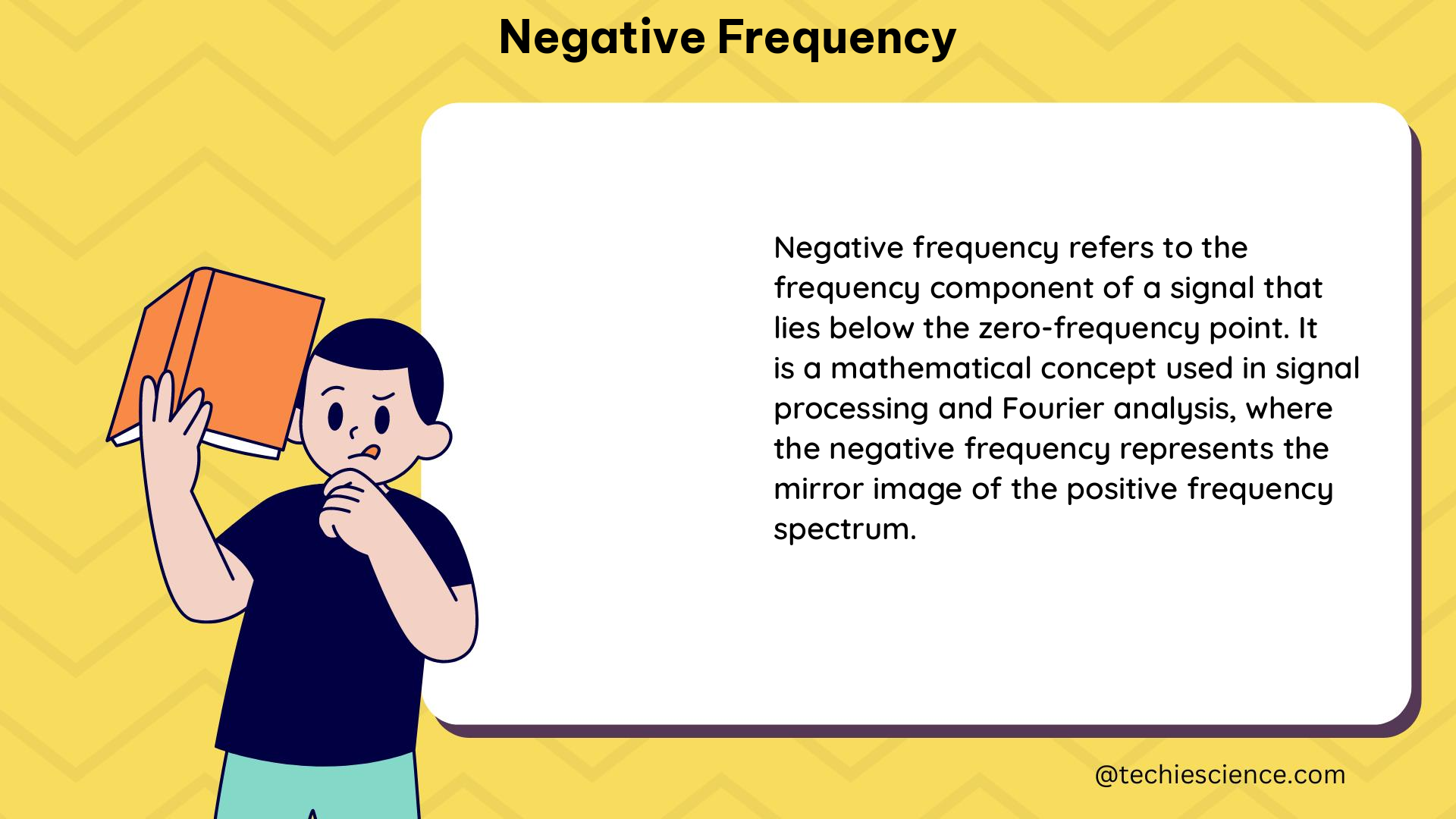Negative frequency is a fundamental concept in signal processing and Fourier analysis, providing a mathematical framework for describing signals that oscillate or vary in a direction opposite to what might be expected. While not a directly measurable quantity, negative frequency can be related to various measurable quantities, offering valuable insights into the nature of signals and the analysis of qualitative data.
Understanding Negative Frequency
Negative frequency arises in the context of the Fourier transform, a powerful mathematical tool used to analyze signals in the frequency domain. In this domain, negative frequencies correspond to complex exponential signals with negative frequencies in radians per second. These negative frequencies can be related to the positive frequencies through the use of complex exponentials, which are mathematically linked to real-valued cosine and sine functions.
Relationship between Positive and Negative Frequencies
The relationship between positive and negative frequencies can be expressed mathematically using the following equation:
x(t) = A cos(2πft + φ) = A/2 * (e^(i2πft + iφ) + e^(-i2πft - iφ))
where:
– x(t) is the time-domain signal
– A is the amplitude of the signal
– f is the frequency of the signal
– φ is the phase of the signal
– i is the imaginary unit (√(-1))
The second part of the equation shows how the cosine function can be expressed as the sum of two complex exponential functions, one with a positive frequency and one with a negative frequency. This relationship is crucial in understanding the role of negative frequencies in signal processing.
Negative Frequencies in the Frequency Domain
In the frequency domain, negative frequencies correspond to complex exponential signals with negative frequencies in radians per second. These negative frequencies can be related to the positive frequencies through the use of complex exponentials, as shown in the equation above.
The Fourier transform, which converts a time-domain signal into the frequency domain, can be expressed as:
X(f) = ∫ x(t) e^(-i2πft) dt
where X(f) is the Fourier transform of the signal x(t). The negative frequency component of the Fourier transform corresponds to the second term in the equation for the cosine function, where the frequency is negative.
Practical Applications of Negative Frequency
While negative frequency itself is not a directly measurable quantity, it can be related to various measurable quantities in the context of signal processing and data visualization.
Signal Processing Applications
In the context of signal processing, negative frequencies can be used to describe the behavior of certain types of signals, such as:
- Cosine Signals: The frequency of a cosine signal can be positive or negative, corresponding to the direction of oscillation.
- Modulated Signals: In amplitude modulation (AM) and frequency modulation (FM) techniques, the modulated signal can be represented as the sum of positive and negative frequency components.
- Analytic Signals: Analytic signals, which are complex-valued functions, can be used to represent the positive and negative frequency components of a real-valued signal.
Understanding the role of negative frequencies in these signal processing applications can provide valuable insights into the behavior and characteristics of the signals being analyzed.
Data Visualization Applications
Negative frequencies can also be related to measurable quantities in the context of data visualization. For example, in a sunburst graphic that illustrates the relationship between different units of qualitative analysis, the relative frequency or percentage of a concept can be represented by the amount of space taken up by the “slice” of the donut or pie.
This representation can be useful for showing the layers of meaning contained in the qualitative data, including any nuances that may be present in open-ended responses. By relating the relative frequency or percentage of a concept to the negative frequency component of the data, researchers and analysts can gain a deeper understanding of the underlying patterns and relationships within the data.
Advanced Concepts in Negative Frequency

Beyond the basic understanding of negative frequency, there are several advanced concepts and techniques that can be explored to deepen one’s understanding of this topic.
Negative Frequency in Quantum Mechanics
In the field of quantum mechanics, negative frequency is closely related to the concept of negative energy states. According to the Dirac equation, which describes the behavior of relativistic electrons, the solutions to the equation include both positive and negative energy states.
The negative energy states correspond to the existence of anti-particles, such as the positron, which is the anti-particle of the electron. The relationship between negative frequency and negative energy states in quantum mechanics is a complex and fascinating topic that has important implications for our understanding of the fundamental nature of reality.
Negative Frequency in Optics and Electromagnetics
In the field of optics and electromagnetics, negative frequency can be related to the concept of negative refractive index materials. These materials, also known as metamaterials, exhibit a negative refractive index, which means that the direction of the propagation of light or electromagnetic waves is opposite to the direction of the energy flow.
The negative refractive index can be related to the negative frequency component of the electromagnetic waves, and this phenomenon has important applications in the design of specialized optical devices and antennas.
Numerical Simulations and Modeling
Negative frequency can also be an important consideration in numerical simulations and modeling of various physical systems. For example, in the simulation of electromagnetic wave propagation, the inclusion of negative frequency components can be crucial for accurately capturing the behavior of the system.
Numerical techniques, such as the Finite Difference Time Domain (FDTD) method, can be used to model the propagation of electromagnetic waves, including the negative frequency components. These simulations can provide valuable insights into the behavior of complex systems and can be used to design and optimize various engineering applications.
Conclusion
Negative frequency is a fundamental concept in signal processing and Fourier analysis, providing a mathematical framework for describing signals that oscillate or vary in a direction opposite to what might be expected. While not a directly measurable quantity, negative frequency can be related to various measurable quantities, offering valuable insights into the nature of signals and the analysis of qualitative data.
By understanding the relationship between positive and negative frequencies, the role of negative frequencies in the frequency domain, and the practical applications of negative frequency in signal processing and data visualization, researchers and analysts can gain a deeper understanding of the signals and data they are working with. Additionally, the advanced concepts of negative frequency in quantum mechanics, optics and electromagnetics, and numerical simulations and modeling, provide further opportunities for exploration and discovery in this fascinating field of study.
References:
– Negative Frequency in Signal Processing
– Quantifying Qualitative Data with Data Visualization
– Understanding Negative Frequencies
– Techniques for Analyzing Open-Ended Survey Responses
– Negative Refractive Index and Metamaterials
– Finite Difference Time Domain (FDTD) Method

I have a background in Aerospace Engineering, currently working towards the application of Robotics in the Defense and the Space Science Industry. I am a continuous learner and my passion for creative arts keeps me inclined towards designing novel engineering concepts.
With robots substituting almost all human actions in the future, I like to bring to my readers the foundational aspects of the subject in an easy yet informative manner. I also like to keep updated with the advancements in the aerospace industry simultaneously.